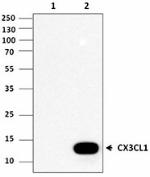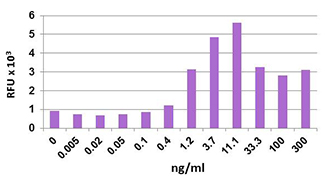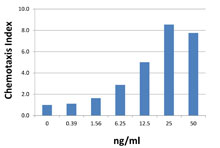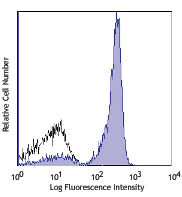- Clone
- L393H11 (See other available formats)
- Regulatory Status
- RUO
- Other Names
- Chemokine (C-X3-C Motif) Ligand 1 (CX3CL1), ABCD-3, Fractalkine, Neurotactin (NTT, NTN), Small Inducible Cytokine Subfamily D (Cys-X3-Cys), Member-1 (SCYD1), CXC3C
- Isotype
- Mouse IgG2b, κ
- Ave. Rating
- Submit a Review
- Product Citations
- publications

-

Western blot analysis of 50 ng recombinant mouse CX3CL1 (lane 1) and human CX3CL1 (lane 2) using anti-human CX3CL1 antibody (clone L393H11).
| Cat # | Size | Price | Quantity Check Availability | Save | ||
|---|---|---|---|---|---|---|
| 661201 | 50 µg | $112 | ||||
| 661202 | 500 µg | $335 | ||||
CX3CL1 is the only member of the CX3C chemokine family that is constitutively expressed in endothelial and epithelial cells, lymphocytes, neurons and microglial osteoblasts. CX3CL1 exists in two forms: as a membrane-anchored form of approximately 100 kD or as a shed 80-95 kD glycoprotein. The chemokine domain is roughly 8 kD, but it migrates at about 13 kD. Its membrane bound form promotes the firm adhesion of rolling leucocytes onto the vessel wall, while its soluble form serves as a potent chemoattractant for CX3CR1-expressing cells such as NK cells, CD14+ monocytes, cytotoxic effector T cells, B cells, neurons, microglia, smooth muscle cells, and tumor cells. The CX3CL1/CX3CR1 axis plays an important role in the pathogenesis of several inflammatory diseases such as allergic pathologies, rheumatoid arthritis, atherosclerosis and tumorigenesis.
Product DetailsProduct Details
- Verified Reactivity
- Human
- Antibody Type
- Monoclonal
- Host Species
- Mouse
- Immunogen
- Recombinant human CX3CL1
- Formulation
- Phosphate-buffered solution, pH 7.2, containing 0.09% sodium azide.
- Preparation
- The antibody was purified by affinity chromatography.
- Concentration
- 0.5 mg/ml
- Storage & Handling
- The antibody solution should be stored undiluted between 2°C and 8°C.
- Application
-
WB - Quality tested
- Recommended Usage
-
Each lot of this antibody is quality control tested by Western blotting. For Western blotting, the suggested use of this reagent is 0.5 - 2.5 µg per ml. It is recommended that the reagent be titrated for optimal performance for each application.
- RRID
-
AB_2563890 (BioLegend Cat. No. 661201)
AB_2563891 (BioLegend Cat. No. 661202)
Antigen Details
- Structure
- Chemokine, membrane bound form includes an extracellular NH2-terminal domain, a mucin-like stalk, a transmembrane α helix, and a short cytoplasmic tail. Full-length CX3CL1 contains over 300 amino acids and is highly glycosylated.
- Distribution
-
Cell membrane, secreted.
- Function
- CX3CL1 has potent chemoattractant activity for T cells, monocytes, and natural killer cells, and the expression of CX3CL1 in activated endothelial cells promotes strong adhesion of those leukocytes. CXC3L1 is induced in endothelial cells by proinflammatory cytokines (TNF-α, IFN-γ, IL-1β) and LPS.
- Interaction
- Monocytic cells, smooth muscle cells, T cells, B cells, NK cells, microglia, and astrocytes.
- Ligand/Receptor
- CX3CR1
- Cell Type
- B cells
- Biology Area
- Cell Adhesion, Cell Biology, Immunology, Signal Transduction
- Molecular Family
- Cytokines/Chemokines
- Antigen References
-
1. Ferretti E, et al. 2014. Mediators Inflamm. 2014:480941.
2. Apostolakis S, et al. 2013. Acta Pharmacol Sin. 34:1251.
3. Julia V, et al. 2012. Allergy. 67:1106.
4. Bazan JF, et al. 1997. Nature 6617:640.
5. Hundhausen C, et al. 2003. Blood 102:1186.
6. Sato E, et al. 2006. Ann. Rheum. Dis. 65:1257.
7. Jones B, et al. 2011. Front. Immunol. 2:82. - Gene ID
- 6376 View all products for this Gene ID
- UniProt
- View information about CX3CL1 on UniProt.org
Related FAQs
Other Formats
View All CX3CL1 Reagents Request Custom Conjugation| Description | Clone | Applications |
|---|---|---|
| Purified anti-CX3CL1 (Fractalkine) | L393H11 | WB |
Customers Also Purchased
Compare Data Across All Formats
This data display is provided for general comparisons between formats.
Your actual data may vary due to variations in samples, target cells, instruments and their settings, staining conditions, and other factors.
If you need assistance with selecting the best format contact our expert technical support team.
-
Purified anti-CX3CL1 (Fractalkine)

Western blot analysis of 50 ng recombinant mouse CX3CL1 (lan...
 Login/Register
Login/Register 











Follow Us